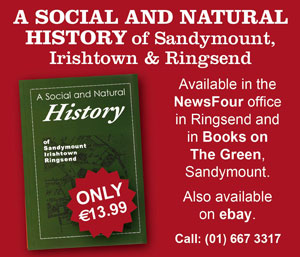
A Docklands based history group have addressed Dublin City Council with a formal submission, hoping to highlight the historical significance of an inner city site which has recently gone up for sale.
The site, in the Docklands neighbourhood of East Wall, was formerly the location of Cahill’s Print Works, last in the news following a fire in 2007, but the East Wall History Group (EWHG) have uncovered indications that the corner of Church Road and East Wall Road may have a greater importance in the history of Dublin’s docks.
NewsFour spoke with Sarah Lundberg of the EWHG group to learn more. She explained that general reading about Dublin and the lack of detail concerning the North Docks led to the group engaging in “the mystery of the Glass House.”
“The South Docks were part of the Pembroke Township as it was constituted at the time but, beyond the Customs House, little is recorded. The area which is now the North Docks was privately owned in bits and pieces,” she says.
Thom’s Irish Almanac and Street Directory for the area as it was in 1857, makes reference to ‘the Fort Crystal glass house, in ruins’ and a number of surrounding cottages, which led the EWHG to believe that one of the earliest manufacturing houses of modern Dublin may have been situated there. Later editions of the directory refer to Fort Crystal Lodge, Fort Crystal Terrace and Fort Crystal Cottage, indicating that an industrial settlement existed adjacent to the glasshouse.
Earlier sources, such as one John Dalton’s 1838 History of the County of Dublin indicate the former presence of a glasshouse near the North Wall, which is near the Cahill site. Additionally, a book published in 1920 with the lengthy title Irish Glass: an Account of Glass-Making in Ireland from the 16th Century to the Present Day features a description of the Docklands glass industry. In discussing bottle-making plants on Sherriff Street and south of the river in Ringsend, author Michael Seymour Dudley refers to maps of Dublin dated from 1819 to 1823 that showed “a glasshouse marked near the East Wall not far from Annesley Bridge”. In the 1819 map, the name Fort Crystal recurs.
Sarah is keen to emphasise that since the Northside Docklands were not developed for industrial and residential habitation until the 19th century, a major piece of the city’s industrial history may be missing. There’s a certain romance to it all. “Fort Crystal would have literally been built from glass, as much as they could at the time, and the terrace may have housed a whole community. How it dropped from local knowledge is kind of a mystery.”
Mysterious, indeed: the Docklands adjacent to the mouth of the Liffey have a long history of glass-making, which makes the forgetting of Fort Crystal notably unusual. The first glass plant in the region opened in Ringsend in 1787 (on Charlotte Quay), and subsequently glass factories were established, and flourished, on Fitzwilliam Street, Fitzwilliam Quay, Cambridge Place and Richard Street. The first automatic bottle-making machine used in Europe was installed in the factory on Charlotte Quay.
The glass manufacture and bottle-making industry remained bustling and healthy up to the late 1920s and the Great Depression. Now seems as apt a time as any to uncover and commemorate what has and hasn’t been forgotten.
Pictured above left: The Fort Crystal site, formerly occupied by Cahill’s Print Works on the East Wall.
By Rúairí Conneely



